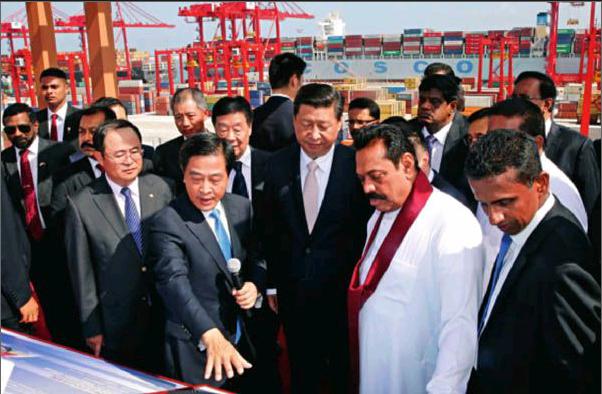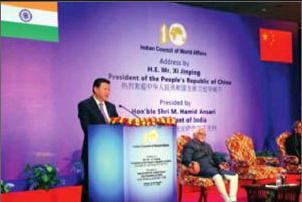China’s New Diplomatic Blueprint for South Asia
2014-12-20ByLINMINWANG
By+LIN+MINWANG


IN September, following his attendance at the 14th Meeting of the Council of the Heads of State of the Shanghai Cooperation Organization (SCO) and his state visit to Tajikistan, Chinese President Xi Jinping began his tour of three South Asian countries: the Maldives, Sri Lanka, and India. It was President Xis first visit to the region since he took office. The trip gave rise to significant improvements in mapping out Chinas new diplomatic blueprint on South Asia, expanding Chinas neighborhood diplomacy, and reshaping world geopolitics.
Pragmatic Cooperation
Xis visit to the Maldives was the first of its kind by a Chinese president in 42 years since the establishment of diplomatic relations between the Maldives and China. It thus held great significance in promoting bilateral ties and pragmatic collaboration between China and South Asian countries. During the visit, China reaffirmed its respect for the independence, sovereignty and territorial integrity of the Maldives, and its high regard for the Maldivian peoples choice of political system and development path according to their particular national conditions. China will continue to support and assist the Maldiveseconomic development and encourage Chinese enterprises to invest in the country. The Chinese government will also support the construction of such projects as the Malé-Hulhule Island cross-sea bridge and the Youth City Project, at the same time as strengthening cooperation in national security, tourism, science, culture, education, human resource training, health care and other aspects. Meanwhile the two sides also plan to strengthen communication and cooperation on global issues such as climate change.
In Sri Lanka, China also expressed its firm support for the countrys efforts in safeguarding its independence, sovereignty and territorial integrity as well as the peoples choice of development path, and unequivocally opposed the behavior of any country or organization that violates the nations independence and political and social stability. The two sides promised to enhance cooperation in maritime economy such as port development and maritime security, and to advance major cooperative projects in port construction, energy, and culture. Both sides will push forward negotiations on a China-Sri Lanka bilateral free trade agreement, and the Chinese government is to encourage more enterprises to actively participate in the construction of industrial parks, special economic zones and infrastructure projects in Sri Lanka. The two sides also vowed to expand exchanges and cooperation in such fields as tourism, culture, education, and religion, and promote Chinese language learning in Sri Lanka.
President Xis visit to India not only improved his personal relations with newly-elected Indian Prime Minister Narendra Modi, but also elevated China-India relations to a new level of pragmatic cooperation. China announced the setting up of two industrial parks in Gujarat and Maharashtra in India and promised to provide an investment of US $20 billion in the coming five years. The two sides signed a memorandum on railway cooperation, and engaged in a discussion on bilateral cooperation in civil nuclear power field. India committed to importing high-speed railway technology from China, while the Chinese part promised to allow easier access to the Nathu La Pass for those making pilgrimages to India. Meanwhile, the two sides exchanged ideas on the sensitive border issue, reiterated their pursuit of a rational and acceptable agenda that is in both sides interests, and indicated their intention to settle the border issue as soon as possible.
“One Belt, One Road”
President Xis South Asian tour plays a significant role in building up the Silk Road Economic Belt and the 21st Century Maritime Silk Road. Since the 18th National Congress of the Communist Party of China, Chinas new leadership has taken a positive stance on diplomatic issues, and put a premium on neighborhood diplomacy. Put forward by President Xi last year, the proposal of“One Belt, One Road” has become a signpost for Chinas strategy to neighboring countries. At the same time, the strategic position of South Asia has been upgraded and recognized as an indispensable part of “One Belt, One Road.” The Bangladesh-China-India-Myanmar (BCIM) Economic Corridor and the Pakistan-China Economic Corridor, proposed by Premier Li Keqiang during his first visit to India, have become an important part of this concept.
As important stops along the ancient maritime Silk Road, the Maldives and Sri Lanka remain vital to Chinas maritime trade transportation because of their prime location between the Middle East and South Asia. Their attitudes are directly relevant to the development of the 21st Century Maritime Silk Road. Maldivian President Abdulla Yameen believes the concept proposed by President Xi is visionary. The Maldives supports the projects and is willing to seize the opportunity and ac- tively participate in relevant cooperation. China said in a joint communiqué that it welcomes the Maldives to participate in the construction of the 21st Century Maritime Silk Road and indicates its willingness to work together with the Maldives to cement bilateral traditional friendship and deepen cooperation hence to achieve common developments.
Sri Lanka, the pearl of the Indian Ocean, has become an important partner for China in the region. China and Sri Lankas joint work to build the 21st Century Maritime Silk Road offers a marvelous opportunity for development on both sides. Meanwhile, support from Sri Lanka is of great significance for China to strengthen its economic ties with Southeast Asia, Africa and Europe.
India, while displaying some reservations concerning“One Belt, One Road,” agrees with the premise of linking up its strategy of economic development with the projects, which means Chinas advantages and Indias development demands will be closely integrated. At the same time, it promises to facilitate the construction of the BCIM Economic Corridor.
Cooperation Framework
During Xis visits, China developed top-level design and strategic planning in bilateral ties together with the Maldives and Sri Lanka respectively, and provided strategic guidance for development of bilateral relations together with India. According to President Yameen, though the Maldives is a small island nation, China respects and attaches importance to the country. The Maldives-China relationship is a model for mutual respect and reciprocal cooperation between big and small countries. During Xis visit, the two top leaders agreed to establish a futureoriented, all-round, friendly and cooperative partnership between their two countries.
China-Sri Lanka relations, positioned in 2013 as a strategic cooperative partnership of sincerity, mutual help and everlasting friendship, have become indispensable to both countries diplomatic policies. In Xis visit to Sri Lanka this year, the two sides signed the action plan to deepen the strategic cooperative partnership, indicating the direction and foundation of buttressing the strategic cooperative partnership, and launched a series of projects.
China and India, apart from fostering a strategic partnership for peace and prosperity, have realized that their progress may help each other forward and have vowed to forge a closer development partnership that will be a core component of their strategic and cooperative venture.
Chinas willingness to more deeply engage in South Asias economic development is supported by the countries in that region, while China equally backs these countries that wish to join the SCO. Reciprocal developments in this regard abound: The Maldives hails Chinas contribution to the development of the South Asian Association for Regional Cooperation (SAARC) and pledges to support Chinas efforts to upgrade its relationship with SAARC; Sri Lanka expects China to contribute more to SAARC as an observer and encourages China to further its cooperation with the association; India agrees to expand its collaboration with China within Asian regional cooperation organizations; and China welcomes Sri Lanka to join the Asian Infrastructure Investment Bank as a founding member, attaches importance to and supports Sri Lankas application for SCO observer status, and is willing to promote all-round cooperation between the SCO and Sri Lanka.

China and India reached a consensus that the priority in Asia is maintaining regional peace and stability while advancing common development of the region. Both countries concur that an open, transparent, equal and inclusive security and cooperation framework based on the fundamental principles of international law should be set up, and they support regional multilateral cooperation mechanisms in Asia.
With regards to global issues, China will enhance coordination with the Maldives in various fields including climate change. In addition, it vows to boost communication and cooperation with Sri Lanka within multilateral mechanisms including the UN and increase cooperation in such fields as human rights, climate change, counterterrorism and combating transnational crime to jointly safeguard the common interests of developing nations. China-India cooperation is even more significant both regionally and globally. India is the biggest country in South Asia and China is its biggest neighbor. Only by joining forces can the two powers stimulate regional peace, stability and prosperity. As two major developing countries, China and India are faced with similar challenges; they have extensive common interests and shoulder great responsibilities in safeguarding the common interests of developing nations and making the international political and economic orders more just and equitable, which requires strong strategic cooperation in global affairs. “If we (China and India) speak with one voice, the whole world will listen, and if we join hands, the whole world will pay attention,” President Xi said during his visit to India.
Over the past year, Xi Jinping has traveled to 13 countries in Central Asia, Southeast Asia, Northeast Asia and South Asia, fostering a favorable neighboring environment for China. Aiming to promote peace, stability and prosperity, his trip to South Asia improved bilateral relations between China and its neighboring countries and advanced the “One Belt, One Road” concept while establishing a future cooperation framework with South Asian countries. However, religious and ethnic conflicts in the region, Indias hegenomic aspirations in South Asia, and the current turbulence in Central Asia have fueled uncertainty about regional development. China has a long way to go in fulfilling its South Asia strategy.
